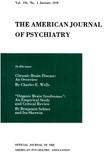PRESENILE DEMENTIA (ALZHEIMER'S DISEASE)
Abstract
Presenile dementia does not appear to be a well-defined clinico-anatomical entity, and single case studies are helpful in elucidating the problem of pathogenesis and classification.
Two cases of presenile dementia are described. One is that of a man who, at the age of 52, developed the typical organic syndrome, with certain signs of focal cortical impairment such as aphasia, paraphasia and disturbances of reading, writing and picture recognition. After severe general deterioration he died at the age of 60, and post-mortem examination revealed the typical histological features of Alzheimer's disease.
The second case is that of a woman who at about the age of 42 began to show unspecific symptoms such as diffuse anxiety, definite phobias and general restlessness, suggestive of a psychoneurosis or the beginning of a functional psychosis. After several years she gradually developed severe disorders of conduct, intellectual and speech impairment. She died in a state of extreme organic dementia and physical deterioration at the age of 48. Post-mortem examination showed severe generalized cortical atrophy (brain weight 864 gms.) with the signs of senility except that the characteristic histological features of Alzheimer's disease were entirely absent.
It has been suggested (Lewy 1925, Spatz 1925) that the process of ageing manifests itself in the central nervous system along two different lines. Atrophy, brown pigment, proliferation of interstitial tissue represent the "primary" phenomena of ageing, and are not confined to the central nervous system or to man. However, the combination of neurofibrillary changes and argentophile plaques is a "secondary" phenomenon of ageing which occurs only in man and in the phylogenetically most recent structures of the nervous system.
The two cases here presented demonstrate that the "primary" and "secondary" phenomena of ageing occur independently. The significance of this fact and its clinical and pathological implications are discussed.
Access content
To read the fulltext, please use one of the options below to sign in or purchase access.- Personal login
- Institutional Login
- Sign in via OpenAthens
- Register for access
-
Please login/register if you wish to pair your device and check access availability.
Not a subscriber?
PsychiatryOnline subscription options offer access to the DSM-5 library, books, journals, CME, and patient resources. This all-in-one virtual library provides psychiatrists and mental health professionals with key resources for diagnosis, treatment, research, and professional development.
Need more help? PsychiatryOnline Customer Service may be reached by emailing [email protected] or by calling 800-368-5777 (in the U.S.) or 703-907-7322 (outside the U.S.).



